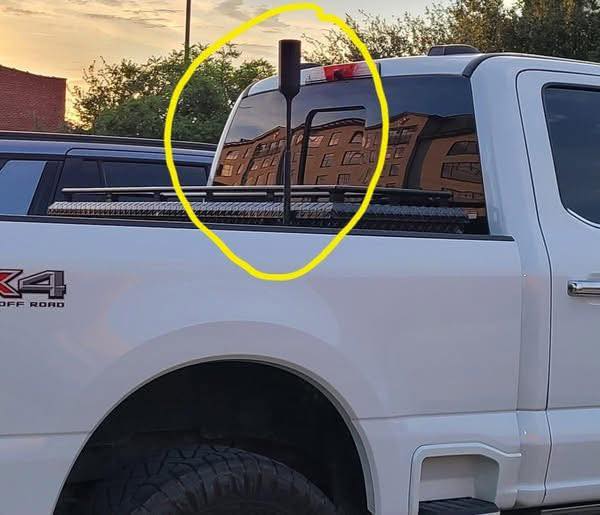If you have ever driven behind a pickup truck and noticed a tall, thin rod rising up from the cab, you may have wondered what it is for. To many, it looks like something left over from the CB radio days, a quirky accessory that truck enthusiasts add for style, or maybe even just an odd decoration. In reality, that pole has a very practical purpose, one that reflects the way modern drivers stay connected in an increasingly digital world.
What you’re seeing is not a relic from the past but an external antenna that forms part of a mobile signal booster system. While it may resemble the antennas that long-haul truckers used for CB radios decades ago, its function today is far more advanced. Instead of handling truck-to-truck chatter, it works to capture and amplify weak cellular signals, allowing phones, tablets, and mobile hotspots to stay connected in places where coverage is otherwise unreliable.
The external antenna is the most visible part of the booster system, essentially acting like a net reaching out to catch signals your phone’s built-in antenna cannot grab on its own. For drivers traveling through rural highways, mountainous terrain, or vast stretches of countryside, losing a signal is frustrating at best and dangerous at worst. The external antenna gathers whatever faint cellular signals are available, feeding them into the booster system installed inside the truck. From there, the signal amplifier strengthens the connection, and the internal antenna rebroadcasts it throughout the cab. The result is clearer phone calls, fewer dropped connections, and faster mobile data speeds.
A typical booster system has three main components: the external antenna mounted outside the truck, the amplifier inside that magnifies the signal, and the internal antenna that redistributes it to devices inside the vehicle. Together, they turn weak, almost useless signals into strong, reliable connectivity. For drivers, this can make the difference between being able to call for help in an emergency and being left stranded without service.
This is why rural drivers, off-roaders, and long-haul truckers depend on these systems. In urban settings, where towers are abundant, an antenna like this might look unnecessary. But for those who live, work, or travel in areas where coverage is spotty, they are essential tools. Farmers and ranchers often need them to stay in contact while working on vast properties. Contractors and delivery drivers rely on them to keep jobs on schedule and clients updated. Even campers and cross-country travelers appreciate the reassurance of being able to reach family, use GPS, or stream music when far from city networks.
And it is not just about phone calls. Signal boosters improve mobile data connections as well, which means mobile hotspots become much more reliable. Popular models such as the weBoost Drive Reach or HiBoost Travel 3.0 allow multiple devices to connect simultaneously. For work crews, families on vacation, or groups of friends traveling together, this can turn long stretches of highway into productive or entertaining hours. Passengers can send emails, browse online, or watch movies without constant disruptions.
The tall rods themselves inevitably remind people of the CB radio era, when truckers filled highways with chatter about traffic conditions and weather alerts. While CB radios are still used by some, smartphones have taken over as the primary tool for communication. The antennas you see today are a modern evolution of that classic look, a nod to the past but with a much different purpose: supporting the digital connectivity that daily life now depends on.
Of course, this convenience comes at a price. A complete signal booster system typically costs between $300 and $500, which may seem like a luxury for casual drivers. But for those who travel regularly through areas with weak coverage, the investment quickly proves its worth. Consider the scenarios: making an emergency call in the middle of nowhere, maintaining contact during long-haul deliveries, using GPS to navigate unfamiliar backroads, or ensuring loved ones can always reach you. Compared to the risks and frustrations of being disconnected, many drivers see it not as a luxury but as a necessity.
The growing popularity of these antennas is tied to lifestyle changes. Remote work, outdoor recreation, and off-the-grid travel are all on the rise, and people want to enjoy the freedom of the open road without losing touch entirely. Overlanding enthusiasts, RV travelers, and even weekend adventurers are increasingly equipping their vehicles with boosters to balance independence with connectivity. This shift means that spotting tall antennas on trucks is becoming more common, and in many circles, it is almost expected gear for serious travelers.
The next time you see a truck with a long rod rising above the cab, you will know it is not just a leftover gadget or an aesthetic choice. It is part of a carefully designed system that serves as a lifeline, ensuring that drivers remain connected no matter how far they travel from cell towers. In a way, it symbolizes the blending of rugged independence with modern digital necessity. For those who value safety, productivity, and peace of mind, that antenna is more than just a pole on a truck—it is the bridge between the isolation of the open road and the connectivity of the modern world.


